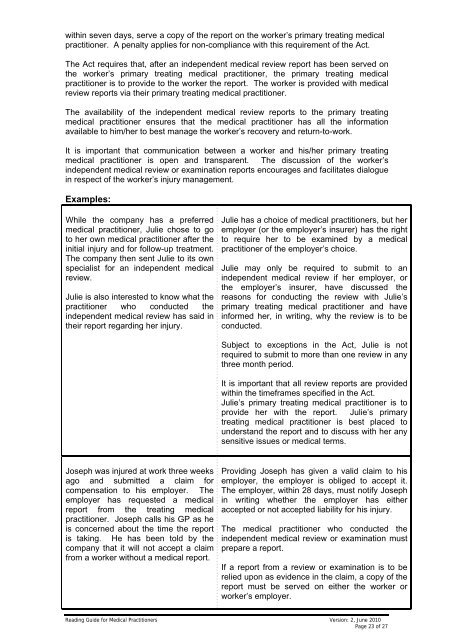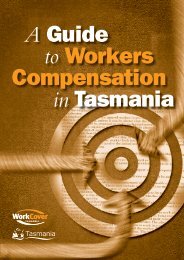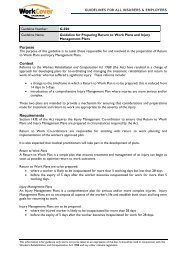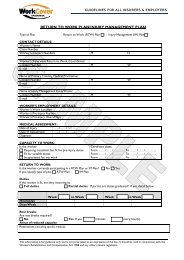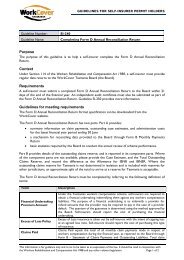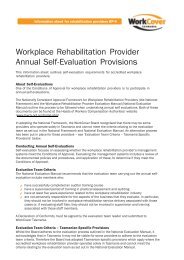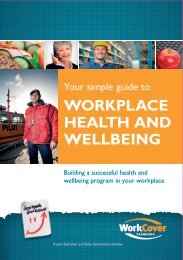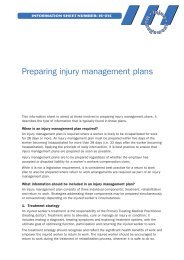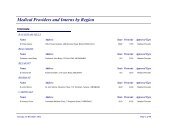Reading Guide for Medical Practitioners - WorkCover Tasmania
Reading Guide for Medical Practitioners - WorkCover Tasmania
Reading Guide for Medical Practitioners - WorkCover Tasmania
Create successful ePaper yourself
Turn your PDF publications into a flip-book with our unique Google optimized e-Paper software.
within seven days, serve a copy of the report on the worker’s primary treating medicalpractitioner. A penalty applies <strong>for</strong> non-compliance with this requirement of the Act.The Act requires that, after an independent medical review report has been served onthe worker’s primary treating medical practitioner, the primary treating medicalpractitioner is to provide to the worker the report. The worker is provided with medicalreview reports via their primary treating medical practitioner.The availability of the independent medical review reports to the primary treatingmedical practitioner ensures that the medical practitioner has all the in<strong>for</strong>mationavailable to him/her to best manage the worker’s recovery and return-to-work.It is important that communication between a worker and his/her primary treatingmedical practitioner is open and transparent. The discussion of the worker’sindependent medical review or examination reports encourages and facilitates dialoguein respect of the worker’s injury management.Examples:While the company has a preferredmedical practitioner, Julie chose to goto her own medical practitioner after theinitial injury and <strong>for</strong> follow-up treatment.The company then sent Julie to its ownspecialist <strong>for</strong> an independent medicalreview.Julie is also interested to know what thepractitioner who conducted theindependent medical review has said intheir report regarding her injury.Julie has a choice of medical practitioners, but heremployer (or the employer’s insurer) has the rightto require her to be examined by a medicalpractitioner of the employer’s choice.Julie may only be required to submit to anindependent medical review if her employer, orthe employer’s insurer, have discussed thereasons <strong>for</strong> conducting the review with Julie’sprimary treating medical practitioner and havein<strong>for</strong>med her, in writing, why the review is to beconducted.Subject to exceptions in the Act, Julie is notrequired to submit to more than one review in anythree month period.It is important that all review reports are providedwithin the timeframes specified in the Act.Julie’s primary treating medical practitioner is toprovide her with the report. Julie’s primarytreating medical practitioner is best placed tounderstand the report and to discuss with her anysensitive issues or medical terms.Joseph was injured at work three weeksago and submitted a claim <strong>for</strong>compensation to his employer. Theemployer has requested a medicalreport from the treating medicalpractitioner. Joseph calls his GP as heis concerned about the time the reportis taking. He has been told by thecompany that it will not accept a claimfrom a worker without a medical report.Providing Joseph has given a valid claim to hisemployer, the employer is obliged to accept it.The employer, within 28 days, must notify Josephin writing whether the employer has eitheraccepted or not accepted liability <strong>for</strong> his injury.The medical practitioner who conducted theindependent medical review or examination mustprepare a report.If a report from a review or examination is to berelied upon as evidence in the claim, a copy of thereport must be served on either the worker orworker’s employer.<strong>Reading</strong> <strong>Guide</strong> <strong>for</strong> <strong>Medical</strong> <strong>Practitioners</strong> Version: 2, June 2010Page 23 of 27


